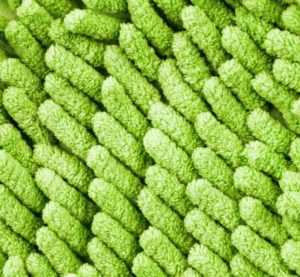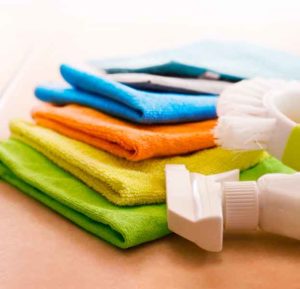Microfibre cloths and mops have experienced a boom in use and popularity over the last decade or so. Many commercial cleaning service providers have moved from more traditional cleaning methods to microfibre cloth based systems. So what exactly is microfibre, and what makes it so special? In this post we explore what it is, where it came from, how it works, and how to properly care for and clean microfibre materials.
What is microfibre?
Microfibre is a synthetic material made from nylon and polyester fibres. These fibres are incredibly fine and when they are woven together, they create a very efficient dirt-trapping weave. The trick is the nylon fibres. These actually have a small static charge, which attracts and holds dirt and debris.

The history of microfibre is, believe it or not, actually quite interesting! There is debate over which country first developed the material and when. Japan has claimed it was invented there back in the 1970s, while others claim it was England in the 1990s. The English even had an ambitious but ultimately unsuccessful attempt at using it to make swimsuits. Wherever it came from originally, microfibre was further developed and marketed for commercial cleaning in the early 2000’s.
Microfibre is most commonly used as dusting and cleaning cloths, but microfibre mops are also significantly more hygienic and efficient than standard cotton mops.
Advantages of microfibre
- The weave in microfibre cloths is very absorbent. It is believed to be capable of holding up to 7 times its own weight in water.
- Microfibre also has an incredibly fast drying time. This is very handy as it can be washed and dried overnight or in the same day, meaning you don’t have to buy or own quite as many cloths.
- Microfibre can be washed and reused time and time again. The material is resilient and long lasting, which makes it a preferred choice for companies offering eco-friendly cleaning services. It significantly reduces the amount of single-use cloths or paper towels.
- Microfibre can remove up to 98% of bacteria from surfaces using only hot water! The cloth attracts and traps microbes so efficiently that it significantly reduces the amount of cleaning sprays and products that need to be used.
- You also don’t need to use much water with a microfibre cloth. Just a small amount will do the job nicely, you can even use them completely dry and still get great results – especially for getting water stains off glass and windows.
- Microfibre is kind to surfaces. Floors, bench tops, windows, wood, steel, and walls are all safe with microfibre – no need to worry about any scratching or damage being done. Small microfibre cloths are also very handy for dusting and cleaning delicate electronics.
Microfibre cloth systems.

No matter what business you are in, hospitality, early childhood, retail, medical – you can reap the benefits of a colour coded cleaning system. You can also buy the cloths and set up a system in your own home!
Microfibre cloth systems are simple but effective. Commercial cleaners will use different coloured cloths for different areas e.g. kitchen, bathrooms, and general cleaning. This prevents cross-contamination, which is especially important in busy places such as schools and offices where large amounts of dirt and bacteria accumulate every day.
How do you clean microfibre?
Once your amazing microfibre cloth has gathered up all the muck, how do you get it clean again? Great question! It is very important to wash your microfibre cloths or mop pads properly. This ensures that the cloths are performing at their best and will extend their lifetime, too. Here are some hints for caring for your microfibre cloths:
- Liquid detergent is preferable over powdered detergents. This is due to the super fine fibres in the cloth that the powder detergent will cling to. This will leave residue over your cloths, making them look dirty again!
- They should be washed separately from other clothes or cleaning cloths. Lint from other types of material might stick to it and make them fluffy. The fluff will then end up all over your nice clean windows!
- Do not use bleach or harsh chemicals or super hot water – there’s really no need! A small quantity of liquid detergent and cold or warm water is all you need. Anything too harsh could also damage the cloth.
- Following on from that, warm temperatures in dryers are also not great for microfibre. It is best to either air dry the cloths, or put them on the low or cool setting in the dryer.
Crewcare uses a microfibre cleaning cloth system as part of their commercial cleaning service. This colour coded system helps to maintain a high level of hygiene, controls the spread of infection, and prevents contamination from other areas. This means you can rest assured that your school cleaning service or workplace cleaning service is carried out properly.
Contact Crewcare today to get your commercial cleaning needs taken care of!


